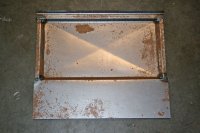Has anybody made their own floor pans by using a bead roller and whatever is used to create the circle and square indentations??? Speaking of which, are the circles stamped or pressed or what?. I apologize for the poor description. I was thinking of buying a bead roller and making floor pans for my CS. I know wolf and a number of other places sell them but I would possibly like to fabricate them.
In summary,
What tools are necessary besides a bead roller?
What tool creates the circular and square indentations?
Should I overlap the floor pans when welding them or butt them up against each other?
While we're on the subject, what about the rocker panels? It looks like they are a much more difficult animal. Does anybody have any suggestions with regard to the rocker panels?
Does anybody have templates they would sell?
Does anybody have any floor pans and rocker panels they want to sell cheap?
I'll have all the worked checked out and cleared by somebody who knows what they're doing.
THanks and have a good day...
In summary,
What tools are necessary besides a bead roller?
What tool creates the circular and square indentations?
Should I overlap the floor pans when welding them or butt them up against each other?
While we're on the subject, what about the rocker panels? It looks like they are a much more difficult animal. Does anybody have any suggestions with regard to the rocker panels?
Does anybody have templates they would sell?
Does anybody have any floor pans and rocker panels they want to sell cheap?
I'll have all the worked checked out and cleared by somebody who knows what they're doing.
THanks and have a good day...


